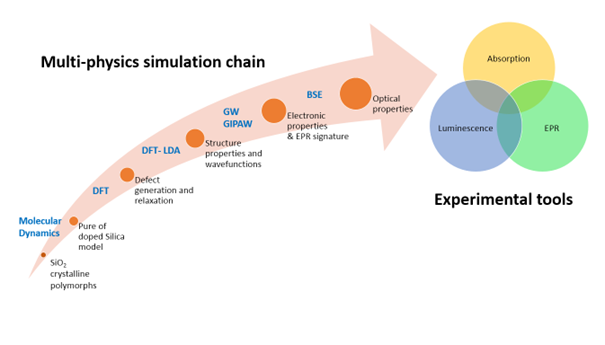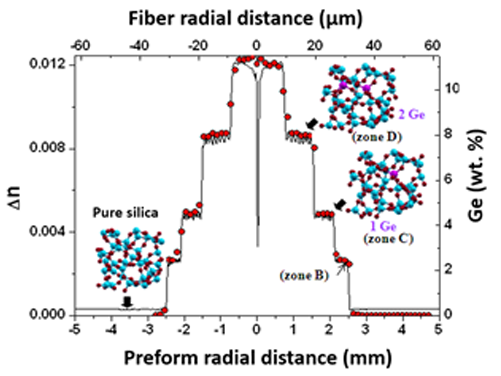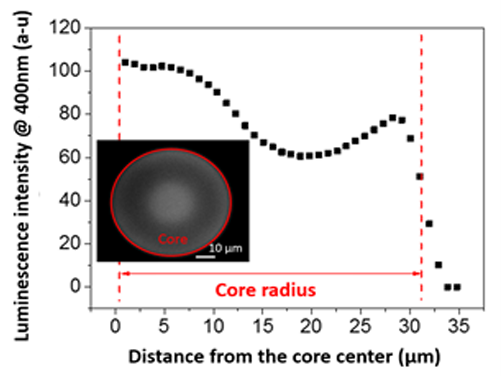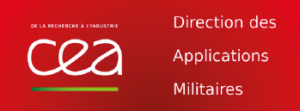- Photonics & Space
LabH6: Optical fibers for theoretical studies
“Canonic” optical fibers for fundamental studies
RADIATION-MATTER INTERACTION MECHANISM
The radiation-induced attenuation and emission in silica fibers or glasses can be explained by the properties of the point defects induced by ionization or atomic displacements [S. Girard et al., TNS, 2013]. The amplitude and the kinetics of degradation related to these defects depend on very many parameters, in particular the fiber properties: composition, drawing conditions… [S. Girard et al., TNS, 2013].
To become able to control the radiation response of optical fibers, it is necessary to identify the nature, the optical properties, the generation and bleaching mechanisms of these defects. The ultimate goal of these fundamental studies is to predict, through simulation, the response of an optical fiber for a given application and a specific environment. Such a predictive tool must be multi-scale and multi-physics to account for the complexity of the radiation-matter interactions.
Fig.1. illustrates the theoretical approach chosen for calculating the optical and structural properties of point defects in dielectrics. In order to validate these ab initio tools, the confrontation between theoretical and experimental results remains indispensable. This is made possible thanks to the manufacturing and the characterization of canonical fibers [S. Girard et al., IEEE TNS, 2008 / N. Richard et al., IEEE TNS, 2014], designed to correspond to the simulation supercells accessible and based on supercomputers, such as TERA 1000 of the CEA.

| COLLABORATIONS Since 2006, LabH6 has been working with CEA DAM and academic partners: Univ. Palermo, Univ. Nova Gorica, CNR TriesteThis work is partly carried out within the framework of a joint research team (ERC, currently being renewed) between the CEA DAM (Arpajon) and the UJM (LabHC) on the study of the basic mechanisms of radiation interaction – dielectrics.At the European level, the consortium is simultaneously working on the fabrication of canonical samples (CEA, LabH6), on their experimental characterization (LabH6, Univ., Palermo) as well as on their theoretical characterization at different scales (CEA, Univ.Trieste, Univ. Gorica). |
SPECTROSCOPIC CHARACTERISATION TOOLS
Many spectroscopic techniques can be used for the characterization of point defects. The main ones are absorption spectroscopy, Raman, luminescence and electron paramagnetic resonance. In situ techniques that can be applied during irradiation should be distinguished from those that can only be performed after irradiation. These later can only provide information on stable defects and not on transient, unstable centers.
In the case of optical fibers, it is often useful to be able to carry out spatially-resolved measurements giving accessto the spatial distribution (cartography) of the defects: an example of in situ measurement by cathodo-luminescence is reported in Fig.3. A recent review paper [S. Girard et al., Reviews in Physics, 2019] summarizes the current knowledge of defects related to pure or doped silica fibers and glasses with the following elements: Ge, P, F, Al.


- Since 2006: More than 15 preforms and 30 “canonical” optical fibers have been developed for fundamental studies: Radiation induced point defects in silica-based optical fibers
Related Publication
-
Radiation Effects on Silica-Based Optical Fibers: Recent Advances and Future Challenges
S. Girard; J. Kuhnhenn; A. Gusarov; B. Brichard; M. Van Uffelen; Y. Ouerdane; A. Boukenter; C. Marcandella
Illustration of the test bench for the mechanical strength of optical fibers before/after irradiation.
https://ieeexplore.ieee.org/document/6457426
